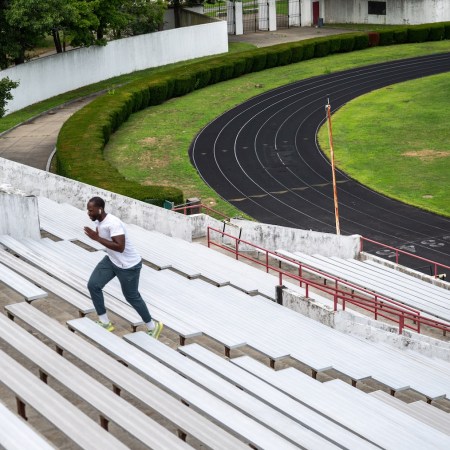This is part of 31 Days, an ongoing fitness series in which a regular guy takes the fitness routines of celebrities and athletes — from Dwayne Johnson to Mark Wahlberg to Arnold Schwarzenegger — for a month-long test drive. Do the regimens live up to the physiques of the superstars behind them? Only one way to find out.
This Saturday, Conor McGregor makes his return to the UFC after a two-year hiatus.
Whether you’re rooting for “The Notorious” Irishman (who has more than earned that nickname in the interim by boxing 10 rounds with Floyd Mayweather, among other things) or Khabib Nurmagomedov, his stoic, 26-0 Russian opponent, there is one thing every spectator can surely agree on:
Between all the haymakers and takedowns, we will all at some point think to ourselves, “Damn, I wish I was in that good of shape.”
Good news: You can be. Or at least that’s the promise of Conor McGregor FAST, the conditioning-focused, zone-based fitness program championed by the MMA megastar.
To see if FAST lives up to the man behind it, I took the regimen for a one-month test drive. Then I dialed Dr. Julian Dalby, MD — one of the physiologists behind the program and a member of McGregor’s personal health and conditioning team — to get some expert insights on how the laymen among us can get the most out of the routine.
Below, a rundown of what exactly McGregor’s conditioning action plan looks like, from workouts to diet to gear to supplements.
It may be too late for most of us to become prizefighters. But training like one? As you’ll see, that’s well within your grasp.
First, a Little Background
If you’ve followed McGregor’s career in any capacity, there’s one glaring issue with the FAST conditioning program. The two most notable losses of his career (to Nate Diaz in 2016, then to Mayweather in a boxing match in 2017) have largely been attributed to his apparent lack of conditioning.
Putting the question of McGregor’s endurance to Dr. Dalby, he had this to say:
“Conor McGregor is an explosive athlete. It’s what enables him to achieve spectacular knockouts. However, it is a double-edged sword that also allows him to empty his fuel tanks quickly. To label this as ‘endurance’ is an oversimplification. MMA is typically a series of anaerobic efforts, so in this instance, endurance is more about recovery between efforts than putting out a low output effort for an extended period of time.”
The word “anaerobic” is important here, as FAST is an acronym for “The Fighter Aerobic/Anaerobic System of Training.” In short, anaerobic exercise means high intensity over short periods (a few seconds to a couple minutes maximum), whereas aerobic exercise means low intensity over longer periods. The FAST program seeks to bridge the two — for McGregor, and now for the rest of us.
“Conor first started using the FAST training system after his shock loss to Nate Diaz at UFC 196,” says Dr. Dalby. Five-and-a-half months after that defeat, he went the full five rounds against Diaz and won. Now that’s an endorsement.
Even for those not stepping into the Octagon anytime soon, McGregor’s description of his first Diaz fight (“… midway through the second round, my gas tank emptied and I could not clear the lactate in my body. I began to drown …”) is a surprisingly familiar feeling. For those who’ve played sports, run races or even taken a HIIT class, chances are you’ve had times when your body wouldn’t allow you to lift, run or even stand for another second. Personally, I experienced that most vividly during my foray into boulder-heaving strongman training.
What exactly is FAST, then?
“FAST was developed by myself and a group of exercise physiologists using data gathered from scientific studies into human performance,” says Dr. Dalby. “The academic data was combined with the experience of Conor McGregor and his team to create practical, effective workouts and training regimens.”
In practice, that means a personalized schedule of 2-4 workouts per week, with a focus on exercising in one of three heart-rate zones (Green, Orange and Red) using one of four pieces of equipment (stationary bike, treadmill, rowing machine and punching bag). Currently you can sign up for FAST at one of two levels: Silver for $20/month or Gold for $95/month, the higher plan offering meal planning and 15-minute weekly Skype consultations.
Full transparency, the FAST team offered to let me test the Silver plan for free. But at that price point, this is a supremely accessible program, and a very enticing one at that — should it deliver results.
Left: McGregor after a Red Zone session (via Instagram) , Right: Me, a mere human
The Methodology
After signing up for FAST, the first order of business was a treadmill ramp test which would determine my personal heart-rate zones. To achieve that, I needed a heart-rate monitor, so I picked up the Wahoo TICKR X. It’s a popular tracker worn around the torso (more accurate than the wrist and the same style worn by McGregor) that accurately tracks a variety of metrics via the company’s RunFit app.
In their online portal, FAST provides a video tutorial demonstrating how to correctly administer the ramp test. Without divulging the proprietary details, it begins with checking your resting heart rate first thing when you wake up (mine was 53 BPM). The Mayo Clinic cites that the average is somewhere between 60 and 100, with well-trained athletes potentially getting as low as 40. On the treadmill, speeds are increased to different levels to determine how your heart rate increases and plateaus.
The data collected from this test is then put into the FAST Zone Calculator, which determines the three zones mentioned above. Basically, the Green Zone designates “light to moderate” exertion, Orange is “hard but sustainable” and Red is “extremely hard.” I began with a Green Zone of 161-169 BPM, Orange 181-189 BPM and Red 190-192 BPM. That seems to check out, as Mayo Clinic cites your maximum exercise heart rate should roughly equate to your age subtracted from 220, which for me is 192.
With that computed, I had to choose to train at a beginner, intermediate or advanced level. Trying to replicate McGregor’s regimen as much as possible, I chose advanced — but as the website notes on multiple pages, the goal is to work smarter, not harder. In other words, you’re not going to impress anyone by choosing a level above what your current physical fitness safely allows.
Finally, I had a customized training schedule, with workouts split into four basic parts: nutrition, stretching, zone conditioning and regular exercise.
This is where most people will diverge from McGregor, whether intentionally or not. The FAST plan simply details the conditioning aspect of his routine, not the fighting technique or training (that would fill the “regular exercise” slot) — a no-brainer to some, but a disappointment to others. On the plus side, it allows you to incorporate it seamlessly into your current workout regimen, whether that’s a McGregor-esque mix of martial arts (boxing, capoeira, tae kwon do, Brazilian jiu-jitsu), or in my case, a mix of HIIT and weightlifting.
The plan is accessible online at all times, but they’ll send you an email on training days with a workout breakdown. While my plan (Silver) didn’t include meal planning or detailed nutrition recommendations, the emails do include four pre- and post-workout supplement suggestions: whey protein, glutamine, BCAA (branched-chain amino acids) and waxy maize starch, in varying amounts depending on the day’s workouts.
Choosing to forego supplements in my day-to-day training, I headed to my friendly neighborhood GNC for some insight. Lucky for me, the employee was quitting that week to go back to Russia to pursue his dream of being a bodybuilder (read: lax steroid laws), so he was shockingly forthcoming about which supplements were bunk and which were legit. He recommended Beyond Raw’s Chemistry Labs L-Glutamine and their Precision BCAA. As for protein, I used iFit’s Nourish shakes, simple once-a-workout-day protein packs that include vitamins, minerals and other nutrients in one go. But any reputable protein powder will do.
Of course, being of the same nationality as McGregor’s opponent, I asked him who he thought will win on Saturday. With a dose of signature Russian unflappability, he said, “We’ll wait and see the fight.”
Schedule, supplements and equipment acquired, all I had to do now was channel the work ethic of the most famous UFC fighter of all time.
Left: McGregor in the Green Zone in Vegas (via Instagram), Right: Me in the Green Zone in NYC
The Takeaways
1. Don’t live and die by the heart-rate monitor
The biggest eye-opener for me was how a simple heart-rate monitor could revolutionize even my daily workout. Being able to work within a zone turns exercise into more of a science, and less of a throwing-darts-in-the-dark type endeavor. That said, it’s still an inexact science. The first day I was slated to hit the Red Zone on a rowing machine, I failed to hit the BPM range on any of my five sets. I eventually got there at the end of the four weeks. But the point is the intention: if you’re consciously working to hit the exertion ranges, you’ll progress.
2. Don’t modify the recommended equipment. Do get instruction.
The exercise physiologists who put FAST together chose the equipment for a reason, so if you’re going to pay the money, don’t substitute. Of the four pieces of equipment, the punching bag is the one your home gym is least likely to stock. That means you’d do well to seek one out, or include boxing or martial-arts classes in with this regimen, if only for the chance to hit the bag on the required days. But before you strap on gloves, get proper instruction on how to hit it … from a trained professional — not your friend Steve who used to get in a lot of bar fights.
3. That said, try both indoor machines and outdoor exercise
If you’ve seen Dr. Dalby before, it’s most likely been in promo videos where McGregor is biking with him in the desert. So on a few of the days where I was supposed to be inside on a stationary bike hitting the Green Zone, I took a bicycle out to the full 6.1-mile loop around Central Park. If McGregor does it, I wanted to do it. But in doing so, I was unable to constantly track my heart rate, my eyes being focused on the various rickshaws, pedestrians, horses and horse droppings. As a result, I wavered more than normal from my desired BPM range. And there’s the reason they were biking in the desert: it’s flat and empty. If you want to take it outside on treadmill or bike days, seek out similarly stable conditions.
4. Have a goal in mind
Pundits love to talk about McGregor’s X factor. But the X factor with any notable fighter, when compared to your average Joe, is the end goal. When they train, they have the extra incentive of eventually being locked in a cage with another person whose objective is to hit them in the head until they quit or black out. To achieve that same motivation, give yourself a challenge you will ultimately have to face, whether it’s a charity fight for amateurs like Haymakers for Hope, a half marathon or even belts in the martial art of your choice. Wanting to look good naked isn’t enough.
5. The final verdict
During my very first email exchange with Dr. Dalby, he gave me these words of warning: “Peak fitness takes a long time to achieve. This is a real program for serious people involved in competition. It is based on real human physiology rather than a marketing promise of something which is biologically not possible to achieve quickly. The program is progressive, so the first four weeks are a relatively easy introduction building up. I feel that you will likely be disappointed in that you do not see overnight changes.”
After four weeks, I can confidently say I was not disappointed. Was there a massive physical change that produced a dramatic, infomercial-worthy before-and-after photo set? No. But the changes I feel in my body are noticeable, even after a relatively short period. During the ramp test on my first day, I was breathing heavily (and sweating profusely) after just 30 minutes. During my first Red Zone rowing day, I couldn’t hit my BPM range. But at the end of the four weeks, I found myself cruising around Central Park and dodging tourists while easily staying within the Green Zone. And during the last week, I hit all of my Red Zone marks while still being able to complete a full workout after without getting gassed or “drowning.”
And my resting heart rate when I woke up on the last day of my training was 48 BPM. The numbers don’t lie.
But for now, I think I owe myself a cheat weekend for the fight, so I’ll be trying a different McGregor program: his spankin’ new Proper No. Twelve whiskey.
Nota bene: If you buy through these links, InsideHook may earn a small share of the profits
The Charge will help you move better, think clearer and stay in the game longer. Subscribe to our wellness newsletter today.

























